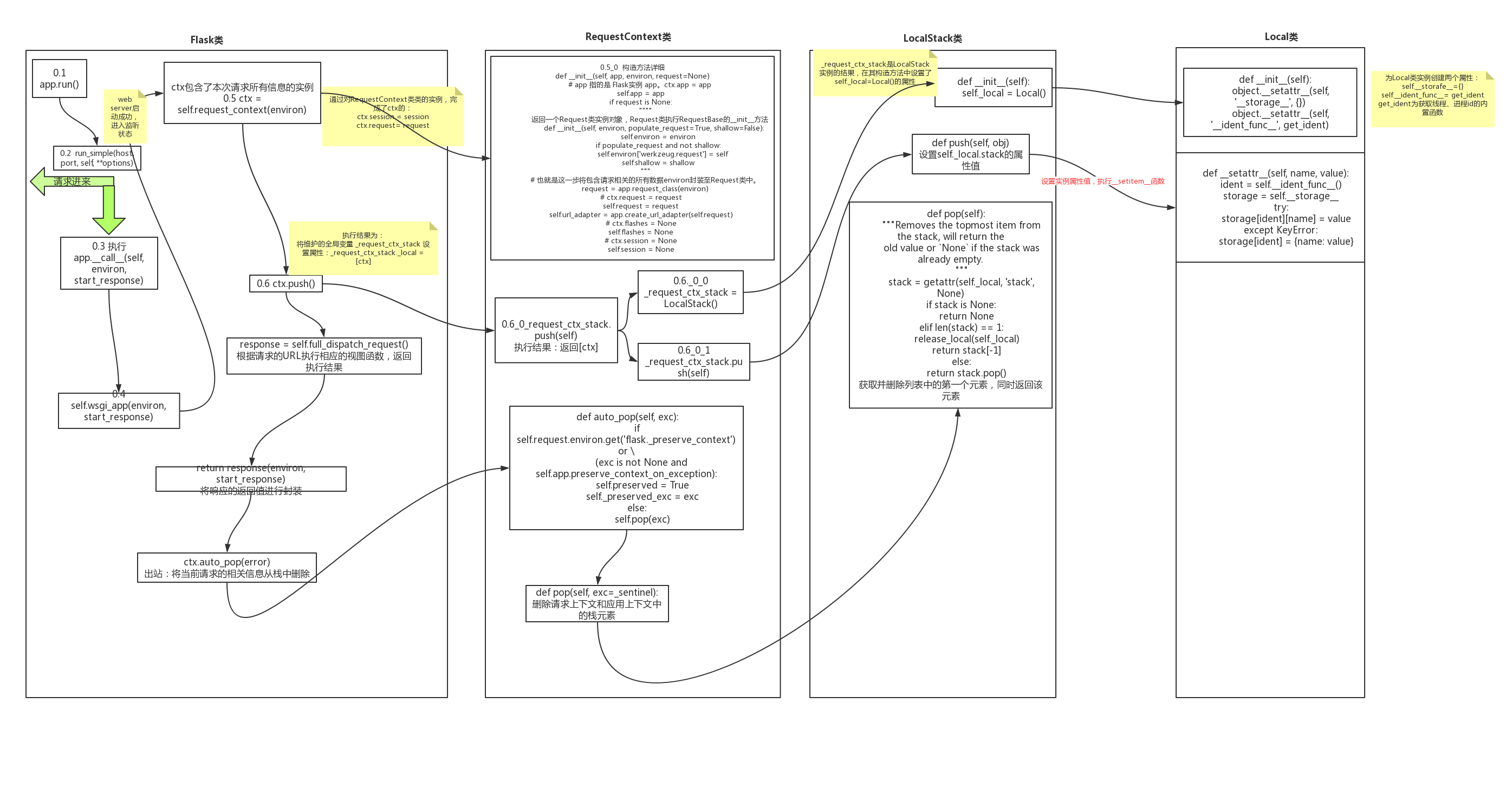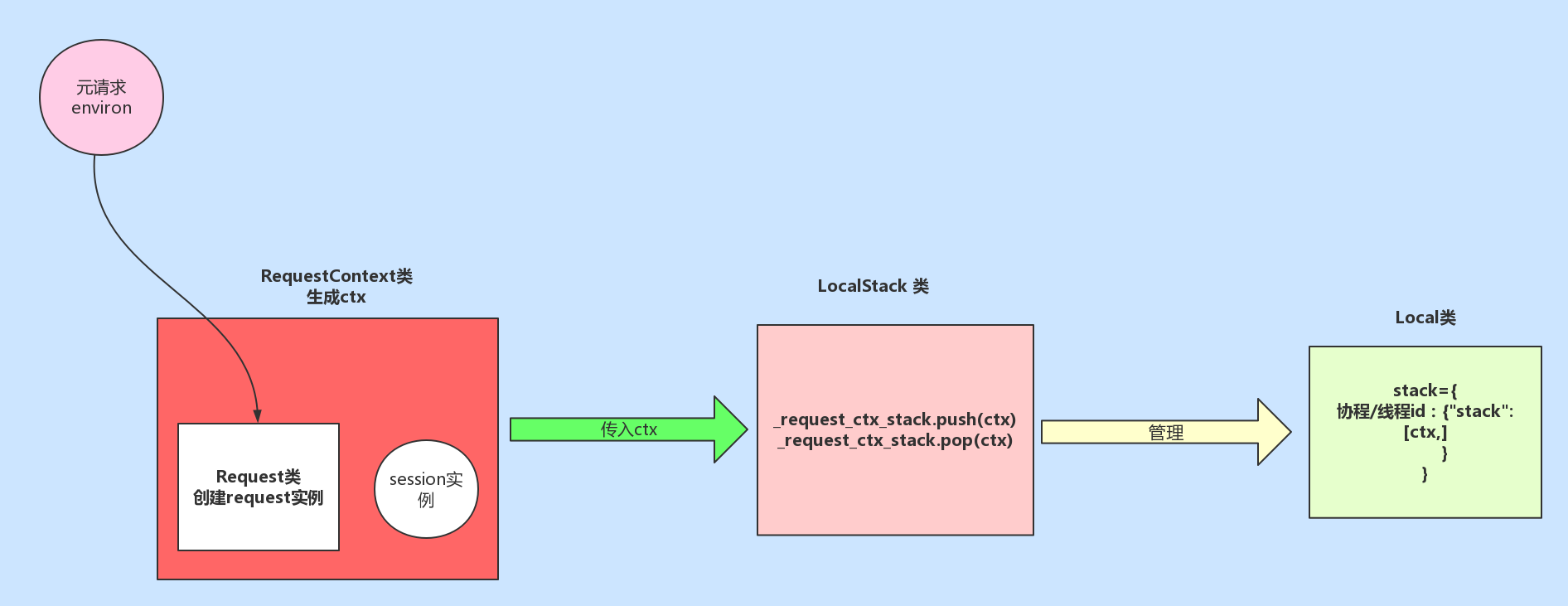size_t ssize_t socklen_t
阅读目录
引入
对于flask而言,其请求过程与django有着截然不同的流程。在django中是将请求一步步封装最终传入视图函数的参数中,但是在flask中,视图函数中并没有请求参数,而是将请求通过上下文机制完成对请求的解析操作。
流程图镇楼:

源码解析
0. 请求入口
if __name__ == '__main__':
app.run()
def run(self, host=None, port=None, debug=None,
load_dotenv=True, **options):
# Change this into a no-op if the server is invoked from the
# command line. Have a look at cli.py for more information.
if os.environ.get('FLASK_RUN_FROM_CLI') == 'true':
from .debughelpers import explain_ignored_app_run
explain_ignored_app_run()
return if get_load_dotenv(load_dotenv):
cli.load_dotenv() # if set, let env vars override previous values
if 'FLASK_ENV' in os.environ:
self.env = get_env()
self.debug = get_debug_flag()
elif 'FLASK_DEBUG' in os.environ:
self.debug = get_debug_flag() # debug passed to method overrides all other sources
if debug is not None:
self.debug = bool(debug) _host = '127.0.0.1'
_port = 5000
server_name = self.config.get('SERVER_NAME')
sn_host, sn_port = None, None if server_name:
sn_host, _, sn_port = server_name.partition(':') host = host or sn_host or _host
port = int(port or sn_port or _port) options.setdefault('use_reloader', self.debug)
options.setdefault('use_debugger', self.debug)
options.setdefault('threaded', True) cli.show_server_banner(self.env, self.debug, self.name, False) from werkzeug.serving import run_simple try:
run_simple(host, port, self, **options)
finally:
# reset the first request information if the development server
# reset normally. This makes it possible to restart the server
# without reloader and that stuff from an interactive shell.
self._got_first_request = False
def __call__(self, environ, start_response):
"""The WSGI server calls the Flask application object as the
WSGI application. This calls :meth:`wsgi_app` which can be
wrapped to applying middleware."""
return self.wsgi_app(environ, start_response)
对于每次请求进来之后,都会执行Flask类实例的__call__方法,至于为什么执行的是__call__方法请看博主之前的《web框架本质》文章,这里不再过多叙述。但是我们可以知道的是,只要是请求进来之后,__call__方法执行的 wsgi_app方法是对请求处理及响应的全部过程,对于每次请求上下文的创建和销毁也是在其内部完成,而上下文正是flask框架的核心,因此研究其内部的执行流程有着至关重要的作用。
首先我们要明白,在上下文中,要完成的操作是:
1.对原生请求进行封装,生成视图函数可操作的request对象
2.获取请求中的cookie信息,生成Session对象
3.执行预处理函数和视图函数
4.返回响应结果
以下为上下文源码,后续对各部分代码进行分别阐述
def wsgi_app(self, environ, start_response):
# 生成 ctx.request , request.session,请求上下文,即请求先关的数据都封装到了 ctx这个对象中去
ctx = self.request_context(environ)
error = None
try:
try:
# 将ctx入栈,但是内部也将应用上下文入栈
ctx.push()
# 对请求的url进行视图函数的匹配,执行视图函数,返回响应信息(cookie)
response = self.full_dispatch_request()
except Exception as e:
# 若发生错误将错误信息最为相应信息进行返回
error = e
response = self.handle_exception(e)
except:
error = sys.exc_info()[1]
raise
# 封装响应信息
return response(environ, start_response)
finally:
if self.should_ignore_error(error):
error = None
# 出栈,删除本次请求的相关信息
ctx.auto_pop(error)
1.请求上下文对象的创建
# 生成 ctx.request , request.session,请求上下文,即请求先关的数据都封装到了 ctx这个对象中去
ctx = self.request_context(environ)
生成RequestContext类实例,该实例包含了本次请求的request和Session信息
def request_context(self, environ):
return RequestContext(self, environ)
对生成的类实例进行初始化,并且将传入的原生请求信息environ封装值Request类实例中。此时,request为封装之后的Request实例,Session为None
class RequestContext(object):
def __init__(self, app, environ, request=None):
self.app = app
if request is None:
request = app.request_class(environ)
self.request = request
self.url_adapter = app.create_url_adapter(self.request)
self.flashes = None
self.session = None
self._after_request_functions = []
self.match_request()
request_class = Request
2. 将请求上下文和应用上下文入栈
# 将ctx入栈,但是内部也将应用上下文入栈
ctx.push()
def push(self):
# 获取到的 top == ctx
top = _request_ctx_stack.top
if top is not None and top.preserved:
top.pop(top._preserved_exc) # Before we push the request context we have to ensure that there
# is an application context.
"""
_request_ctx_stack 和 _app_ctx_stack 都是 Local 类的实例
"""
# 获取 应用上下文的栈顶元素,得到 app_ctx
app_ctx = _app_ctx_stack.top
if app_ctx is None or app_ctx.app != self.app:
# self.app == Fask()
# 得到 一个 AppContext类的实例对象,得到一个 应用上下文对象 app_ctx,此时 app_ctx拥有以下属性: app_ctx.app = app, app_ctx.g = app.app_ctx_globals_class()
app_ctx = self.app.app_context()
# 将 app_ctx 入栈,应用上下文入栈
app_ctx.push()
self._implicit_app_ctx_stack.append(app_ctx)
else:
self._implicit_app_ctx_stack.append(None) if hasattr(sys, 'exc_clear'):
sys.exc_clear() # self 指的是 ctx,即将ctx入栈,即 _request_ctx_stack._local.stack = [ctx]。请求上下文入栈
_request_ctx_stack.push(self)
# 由于每次请求都会初始化创建你ctx,因此session都为None
if self.session is None:
# SecureCookieSessionInterface()
# session_interface = SecureCookieSessionInterface(),即session_interface就是一个SecureCookieSessionInterface类的实例对象
session_interface = self.app.session_interface
# 第一次访问:生成一个 字典(容器) 返回至 self.session
self.session = session_interface.open_session(
self.app, self.request
)
if self.session is None:
self.session = session_interface.make_null_session(self.app)
首先,应用上下文入栈,这里不多做解释说明,其执行流程与请求上下文相同,请参考下文对与请求上下文的入栈流程分析。
其次,请求上下文入栈。执行 _request_ctx_stack.push(self) ,我们先看看 _request_ctx_stack 是什么。由 _request_ctx_stack = LocalStack()
可知 _request_ctx_stack 是 LocalStack 类实例对象,进入 LocalStack 的构造方法中
def __init__(self):
self._local = Local()
即在类实例化过程中,为 _request_ctx_stack 实例对象创建 _local 属性,该属性的值是 Local 类实例,进入其构造方法中,在该方法中为每一个 Local 类实例创建 __storage__ 和 __ident_func__ 属性:
class Local(object):
__slots__ = ('__storage__', '__ident_func__') def __init__(self):
object.__setattr__(self, '__storage__', {})
object.__setattr__(self, '__ident_func__', get_ident)
至此,完成了对 _request_ctx_stack 实例对象创建的流程分析,但是需要注意的是,该实例对象并不是在每次请求之后才创建完成的,而是在flask项目启动之后就会被立即创建,该对象对于每次的请求都会调用该对象的push方法进行请求上下文的入栈,也就是说 _request_ctx_stack 是一个单例对象,该单例对象可以在任何的地方被调用,其他的单例对象还有:
"""
注意:
在项目启动之后,global里的代码就已经执行完毕,而且也只会执行一次,因此这里面的变量是针对所有请求所使用的,但是根据不同线程id用来存放各自的值
"""
# 生成 请求上下文栈对象,将请求上下文对象 ctx 保存到 _request_ctx_stack._local.stack = [ctx]中
_request_ctx_stack = LocalStack()
# 生成应用上下文栈对象,将应用上下文对象 app_ctx 保存到 _app_ctx_stack._local.stack = [app_ctx]中
_app_ctx_stack = LocalStack() # current_app.__local = app
current_app = LocalProxy(_find_app)
# 获取ctx.request
request = LocalProxy(partial(_lookup_req_object, 'request'))
# 获取 ctx.session
session = LocalProxy(partial(_lookup_req_object, 'session'))
# 维护此次请求的一个全局变量,其实就是一个字典
g = LocalProxy(partial(_lookup_app_object, 'g'))
对于以上的单例对象,在项目启动之后被创建,在项目停止后被销毁,与请求是否进来无任何关系。现在我们知道了 _request_ctx_stack 的创建流程,我们返回之前对请求上下文的入栈操作 _request_ctx_stack.push(self) (self指的是ctx),进入push方法:
def push(self, obj):
# obj == ctx
"""Pushes a new item to the stack"""
rv = getattr(self._local, 'stack', None)
if rv is None:
self._local.stack = rv = []
rv.append(obj)
return rv
在上述流程中,首先使用反射获取 _request_ctx_stack._local.stack 的值,也就是获取请求栈的值。项目刚启动,在第一次请求进来之前,请求栈的为空,则代码继续向下执行将当前请求的ctx追加至请求栈中,并且返回请求栈的值。这里着重说一下入栈之前的流程和入栈之后的数据结构:执行 self._local.stack = rv = [] ,会调用 Local 类的 __setattr__ 方法
def __setattr__(self, name, value):
ident = self.__ident_func__()
storage = self.__storage__
try:
storage[ident][name] = valueexcept KeyError:
storage[ident] = {name: value}
self.__ident_func__() 为获取当前此次请求的协程id或者线程id, self.__storage__ 为一个字典对象,在项目启动后的第一个请求进来之后会发生 storage[ident][name] = value 的异常错误,抛出异常被下面捕获,因此执行 storage[ident] = {name: value} (以此次协程id或线程id为key,该key的value为一个字典,在字典中存储一个键值对"stack":[ctx]),即此数据结构为:

_request_ctx_stack._local.stack={
线程id或协程id: {
'stack': [ctx]
}
}

同时, self._local.stack = [ctx]。至此,完成请求上下文的入栈操作,应用上下文与请求上下文的入栈流程相同,这里不在赘述。至此完成了请求入栈的操作,我们需要知道在上述过程中使用到的四个类: RequestContext (请求上下文类,实例对象ctx中包含了request,Session两个属性)、
Request (对请求的元信息environ进行封装)、 LocalStack (使用该类实例对象 _request_ctx_stack ,维护请求上下文对象ctx的入栈和出栈操作,相当于请求上下文对象的管理者)、 Local (堆栈类,真正存放请求上下文的类),如果你还是对着几个类关系还是不明白,请看我为你准备的图:

返回 wsgi_app 函数,继续向下执行 response = self.full_dispatch_request() 函数:
def full_dispatch_request(self):
# 将 _got_first_request = True,依次执行定义的 before_first_request 函数
self.try_trigger_before_first_request_functions()
try:
# 触发 request_started 信号
request_started.send(self)
# 执行钩子函数:before_request,before_first_request
rv = self.preprocess_request()
# 如果执行的before_request,before_first_request函数没有返回值,则继续执行视图函数。若有返回值,则不执行视图函数
if rv is None:
# 执行此url对应的别名的视图函数并执行该函数,返回视图函数的返回值,得到相应信息
rv = self.dispatch_request()
except Exception as e:
# 如果发生错误,则将异常信息作为返回值进行返回
rv = self.handle_user_exception(e)
# 封装返回信息并返回,包括 session
return self.finalize_request(rv)
在函数的内部首先执行预处理函数再执行视图函数,返回预处理函数或视图函数的返回值至浏览器。
返回 wsgi_app 函数中,继续向下执行 ctx.auto_pop(error) 函数,完成对请求上下文和应用上下文的出栈操作:
def auto_pop(self, exc):
if self.request.environ.get('flask._preserve_context') or \
(exc is not None and self.app.preserve_context_on_exception):
self.preserved = True
self._preserved_exc = exc
else:
self.pop(exc)
def pop(self, exc=_sentinel):
"""Pops the request context and unbinds it by doing that. This will
also trigger the execution of functions registered by the
:meth:`~flask.Flask.teardown_request` decorator. .. versionchanged:: 0.9
Added the `exc` argument.
"""
app_ctx = self._implicit_app_ctx_stack.pop() try:
clear_request = False
if not self._implicit_app_ctx_stack:
self.preserved = False
self._preserved_exc = None
if exc is _sentinel:
exc = sys.exc_info()[1]
self.app.do_teardown_request(exc) # If this interpreter supports clearing the exception information
# we do that now. This will only go into effect on Python 2.x,
# on 3.x it disappears automatically at the end of the exception
# stack.
if hasattr(sys, 'exc_clear'):
sys.exc_clear() request_close = getattr(self.request, 'close', None)
if request_close is not None:
request_close()
clear_request = True
finally:
# 请求上下文出栈
rv = _request_ctx_stack.pop() # get rid of circular dependencies at the end of the request
# so that we don't require the GC to be active.
if clear_request:
rv.request.environ['werkzeug.request'] = None # Get rid of the app as well if necessary.
if app_ctx is not None:
# 应用上下文出栈
app_ctx.pop(exc) assert rv is self, 'Popped wrong request context. ' \
'(%r instead of %r)' % (rv, self)
def pop(self):
"""Removes the topmost item from the stack, will return the
old value or `None` if the stack was already empty.
"""
stack = getattr(self._local, 'stack', None)
if stack is None:
return None
elif len(stack) == 1:
release_local(self._local)
return stack[-1]
else:
# 获取并删除列表中的第一个元素,同时返回该元素
return stack.pop()
stack获取到的是请求栈或应用栈的列表,栈的长度为1,则进入 elif 控制语句中,首先执行 release_local(self._local) :
def release_local(local):
local.__release_local__()
local=self._local ,即执行 Local 类的 __release_local__ 方法,进入该方法:
def __release_local__(self):
# 将 self.__storage__ 所维护的字典中删除当前协程或线程id为key的元素
self.__storage__.pop(self.__ident_func__(), None)
从上面的语句中可以很明显看出,要执行的操作就是将以当前协程或线程id为key的元素从字典 self.__storage__ 中删除,返回至pop函数中的elif控制语句,最终将列表中的最后一个元素返回。注意,最终 _request_ctx_stack._local 的请求栈和应用栈列表中至少会存在一个元素。
https://www.cnblogs.com/liuyinzhou/p/9769490.html
size_t ssize_t socklen_t的更多相关文章
- size_t ssize_t loff_t 的区别
Ssize_t 与size_t 跟踪linux源码得到以下宏: #ifndef _SIZE_T #define _SIZE_T typedef __kernel_size_t size ...
- linux c/c++
string 字符串操作 操作数的都是 ( char * )型,操作数必须是指向字符串的指针("a"),不能是字符('a'),操作时不考虑末尾的'\0'. size_t strle ...
- linux 网络编程-基础篇01
#Socket简介 是一个编程接口是一种特殊的文件描述符(everything in Unix is a file)并不仅限于TCPIP协议面向连接(Transmission Control Prot ...
- 快速学习C语言三: 开发环境, VIM配置, TCP基础,Linux开发基础,Socket开发基础
上次学了一些C开发相关的工具,这次再配置一下VIM,让开发过程更爽一些. 另外再学一些linux下网络开发的基础,好多人学C也是为了做网络开发. 开发环境 首先得有个Linux环境,有时候家里机器是W ...
- C 数据类型 长度
----数据类型长度 C99标准并不规定具体数据类型的长度大小.计算机具有不同位数的处理器,16,32和更高位的64位处理器,在这些不同的平台上,同一种数据类型具有不同的长度. char,short, ...
- <转>32位移植到64位 注意事项
32bit-64bit porting work注意事项 64位服务器逐步普及,各条产品线对64位升级的需求也不断加大.在本文中,主要讨论向64位平台移植现有32位代码时,应注意的一些细小问题. 什么 ...
- cc代码学习笔记1
#define #define INT32 int #define INT8 char #define CHAR char #define SSHORT signed short #define IN ...
- apue.h
[root@localhost unix_env_advance_prog]# cat apue.h #ifndef _APUE_H #define _APUE_H #define _XOPEN_SO ...
- LED字符设备驱动实例及测试代码
驱动代码如下: #include <linux/kernel.h>//内核头文件 #include <linux/init.h>//__init等 #include <l ...
随机推荐
- Spring Data JPA实体详解
1. Spring Data JPA实体概述 JPA提供了一种简单高效的方式来管理Java对象(POJO)到关系数据库的映射,此类Java对象称为JPA实体或简称实体.实体通常与底层数据库中的单个关系 ...
- 如何判断Android手机当前是否联网?
如果拟开发一个网络应用的程序,首先考虑是否接入网络,在Android手机中判断是否联网可以通过 ConnectivityManager 类的isAvailable()方法判断, 首先获取网络通讯类的实 ...
- jsp地址栏传中文显示乱码解决方法
格式一: 地址栏显示格式:http://localhost:8081/Jsp2/ahref2.jsp?id=32&name=%E7%8E%8B%E4%BA%91%E9%B9%8F 1.修改To ...
- VSCode调试Html中的脚本 vscode前端常用插件推荐,搭建JQuery、Vue等开发环境 vsCode 添加浏览器调试和js调试的方法总结 VS Code - Debugger for Chrome调试js
一.背景 使用Visual Studio Code写了一个简单的Html页面,想调试下其中script标签里的javascript代码,网上查了一通,基本都是复制粘贴或者大同小异的文章,就是要安装De ...
- python练习笔记——计算1/1-1/3+1/5-1/7……的和
1 / 1 - 1 / 3 + 1 / 5 - 1 / 7 + ....求100000个这样的分式计算之为是多少?将此值乘以4后打印出来,看看是什么? num_list = [] count = -1 ...
- OAF_OAF控件系列2 - LOV的实现(案例)
2014-06-02 Created By BaoXinjian
- php 仿thinkphp的sql类库
模仿thinkphp封装的类库 <?php /** * MySql操作类2015版 * 作者:咖啡兽兽 287962566@qq.com * 使用说明: * //包含文件 * inclode ' ...
- 利用ichart绘制网页图表
首先,最好的教程在这里:ichartjs 有了这个网站,要绘制网页图表简直方便愉快! 接下来说一下使用方法~~~ 进入网站,点击在线设计器 在线设计器的使用方法就不说了,摸索一下就会了!关键在于两个地 ...
- unity hide/show text
using UnityEngine;using System.Collections; public class PlayerController:MonoBehaviour{ public U ...
- xpages的combobox提前输入值
之前的文档已经提到怎么在combobx手动输入.哪我们如何能够在combobox默认获取值呢?下面有几个种方法请大家參考 1)获取当前数据库某视图的某列值 @DbColumn(&quo ...
